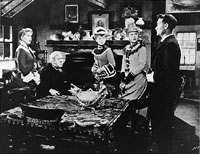

comedy
1953
bw 102 min.
Director: David Lean
CLV: $49.95 - available
1 disc, catalog # CC1411L

Although the English actor Charles Laughton-pale, fleshy, and irredeemably
unwholesome-looking-hated his own appearance,
he wasn't shy about taking creative advantage of his physical shortcomings.
In his best-remembered role, as Quasimodo in William Dieterle's 1939 The
Hunchback of Notre Dame, Laughton's unattractiveness, exaggerated by
makeup, has a poignant effect: We're meant to feel the cruel disparity
between the character's alarming exterior and his gentle, noble soul. But
in other films, Laughton seems to wallow in grotesqueness, to take a
perverse and almost masochistic delight in presenting himself as a man
whose spiritual corruption is all too evident in his puffy features and his
soft, sated physique. Playing villains of various stripes in The Sign of
the Cross (1932), Island of Lost Souls (1933), Mutiny on the Bounty (1935),
The Big Clock (1947), and Salome (1953)-among others-he explores the human
capacity for evil with enormous, terrifying relish.
In Hobson's Choice, David Lean's film adaptation of a popular 1915 stage
comedy by Harold Brighouse, Laughton brings that
diabolic gusto to bear on a character who is, as Brighouse wrote him, just
an ornery, narrow-minded Victorian tradesman. Henry Hobson is the
prosperous owner of a boot shop in Salford, Lancashire, and at the
beginning of the story he positively reeks of self-satisfaction. He's a
widower, with three grown daughters to mind his shop (unpaid), serve his
meals, and generally facilitate his stately march through life. Serenely
confident of his standing as a pillar of the community, Hobson mostly
leaves the running of his business to his eldest and shrewdest daughter,
Maggie (Brenda de Banzie), while he spends his time swilling pints with his
fellow
pillars at the local pub. All these men obviously see themselves as the
solidest of citizens; Hobson, typically, stands with his hands hooked in
his vest pockets and his ample belly thrust forward, as if his bulk were
the proof of his importance. But Laughton's pitiless performance reveals
that solidity as a self-aggrandizing illusion. What men like Hobson are
made of, the actor tells us, is nothing but booze and bluster-liquid and
gas.
Lean, audaciously, allows the star to portray Hobson as a belching, bloated
monster; at times, this Hobson's Choice (the third screen version of the
material) plays like a horror movie. The screenplay, by Lean, Norman
Spencer, and Wynyard Browne, gives Hobson more scenes than the play does,
and the effect is devastating: The more you see of this character, the less
likely you are to indulge his weaknesses. There isn't a trace of affection
for Hobson and his kind in the movie. (There is, however, considerable
evidence of the director's love and respect for his leading man: Lean
provides Laughton with several spectacular comic set pieces-most notably, a
scene in which Hobson, tottering home from the pub, chases the moon's
reflection from puddle to puddle.) The play, although it's constructed to
give the protagonist his comeuppance, betrays a sneaking sympathy for his
rude, obstinate Northern manners. The movie siphons off the last drops of
sympathy for Hobson and redistributes them to the characters who deserve
them: the rebellious Maggie, and Willie Mossop (John Mills), a timid,
illiterate bootmaker in Hobson's employ, whom she resolves to marry.
Maggie pounces on the unsuspecting Willie like a hawk swooping down on a
field mouse, but as the movie goes along we begin to understand that he
isn't her prey. The lovely, fine-textured acting of de Banzie and Mills
persuades us that this is a genuine romance: improbable, and perhaps a
shade more pragmatic than we're used to, but undeniably strong and deep.
And, in any event, the bones that Maggie intends to pick are the rather
meatier ones of Hobson himself. By the end, she has nibbled him to almost
nothing: a pathetic skeleton of smug Victorian patriarchy. It's a
wonderfully satisfying spectacle.
Hobson's Choice was the last film David Lean made in England, and his last
in black and white; three years later, The Bridge on the River Kwai
established his reputation as a director of epics, an identity that stuck
to him until his death in 1988. This picture falls in the uncertain middle
period of Lean's work, between his modest-scaled triumphs of the '40s
(Brief Encounter, Oliver Twist, Great Expectations) and the Oscar®-ready
widescreen blowouts of his later career. Among Lean's classics, Hobson's
Choice is bound to disappoint anyone hoping for a cozy English comedy. For
all the picture's visual elegance, its tone is too volatile for comfort. It
would be a mistake to think of Hobson's Choice as a nostalgic period piece.
The movie actually has less in common with its theatrical predecessors than
with its successors: Its comic savagery provides a faint but recognizable
foretaste of the subversive irony of dramatists like John Osborne and
Dennis Potter. In this film, Lean asks his star to embody a very English
kind of ugliness. Laughton is more than equal to the challenge.
-Terrence Rafferty
Terrence Rafferty is a film critic for The New Yorker and the author of The
Thing Happens (Grove Press).




